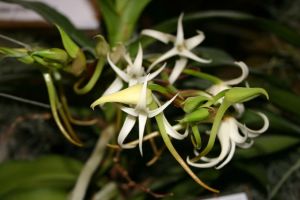No edit summary |
No edit summary |
||
| Line 11: | Line 11: | ||
A widespread, small sized, cool to hot growing epiphyte or occasional monopodial lithophyte from Benin, Ghana, Guinea, Ivory Coast, Liberia, Nigeria, Senegal, Sierra Leone, Togo, Burundi, Central African Republic, Cameroon, Gabon, Gulf of Guinea Islands, Rwanda, Democratic Republic of the Congo, Ethiopia, Kenya, Tanzania, Uganda, Malawi, Mozambique, Zambia, Zimbabwe, Swaziland, Cape Province, Natal, and Transvaal South Africa found most often in woodlands but sometimes riverine forests at or around elevations of 600m to 2500m that has a stout, long, pendulous, stem enveloped by presistent, distichous, dark brown leaf sheaths carrying many, robust aerial roots and 6 to 12, oblong, obliquely apically bilobed, fleshy coriaceous leaves needs bright light to bloom well with an axillary, bracteate, raceme up to 20cm in length, with up to 10 to 14 waxy, nocturnally sweetly fragrant flowers with prominent bracts occurring in the summer. This species is best grown in a basket or mounted on treefern and needs high humidity, cool to warm temperatures and a cooler and drier winter rest. | A widespread, small sized, cool to hot growing epiphyte or occasional monopodial lithophyte from Benin, Ghana, Guinea, Ivory Coast, Liberia, Nigeria, Senegal, Sierra Leone, Togo, Burundi, Central African Republic, Cameroon, Gabon, Gulf of Guinea Islands, Rwanda, Democratic Republic of the Congo, Ethiopia, Kenya, Tanzania, Uganda, Malawi, Mozambique, Zambia, Zimbabwe, Swaziland, Cape Province, Natal, and Transvaal South Africa found most often in woodlands but sometimes riverine forests at or around elevations of 600m to 2500m that has a stout, long, pendulous, stem enveloped by presistent, distichous, dark brown leaf sheaths carrying many, robust aerial roots and 6 to 12, oblong, obliquely apically bilobed, fleshy coriaceous leaves needs bright light to bloom well with an axillary, bracteate, raceme up to 20cm in length, with up to 10 to 14 waxy, nocturnally sweetly fragrant flowers with prominent bracts occurring in the summer. This species is best grown in a basket or mounted on treefern and needs high humidity, cool to warm temperatures and a cooler and drier winter rest. | ||
<googlemap version="0.9" lat=" | <googlemap version="0.9" lat="7.5" lon="13.0" type="hybrid" zoom="2" width="500" height="350" selector="no" controls="none"> | ||
9.30769, 2.315834, Benin | 9.30769, 2.315834, Benin | ||
Benin | Benin | ||
Revision as of 22:42, 27 July 2009

Common Name: The Bow-Shaped Raceme Cyrtorchis
Scented: yes, nocturnal
Light Requirements: full sun
Temperature Requirements: cool to hot
Blooms: summer
Flower Size: 3.75cm
Synonyms: Angorchis arcuata (Lindl. ex Hook. f.) Kuntze 1891; Angorchis sedenii Kuntze 1891; *Angraecum arcuatum Lindley 1866; Angraecum sedeni L. Linden & Barb. Rodr. 1884; Angraecum sedenii (Rchb.f.) N.E.Br. 1882; Angraecum sedenii (Rchb.f.) G.Nicholson 1884; Angraecum whytei (Rolfe) De Wild. 1916; Cyrtorchis arcuata subsp. leonensis Summerh. 1960; Cyrtorchis arcuata subsp. whytei (Rolfe) Summerh. 1960 ; Cyrtorchis arcuata var. variabilis (Summerh.) Geerinck 1988; Cyrtorchis arcuata var. whytei (Rolfe) Geerinck 1992; Cyrtorchis bracteata Schltr. 1915; Cyrtorchis neglecta Summerhayes 1960; Cyrtorchis sedeni [Rchb.f] Schlechter 1918; Cyrtorchis whytei (Rolfe) Schltr. 1918 ; Listrostachys arcuata [Lindley] Rchb.f 1864; Listrostachys sedeni Rchb.f 1878; Listrostachys whytei Rolfe 1898
A widespread, small sized, cool to hot growing epiphyte or occasional monopodial lithophyte from Benin, Ghana, Guinea, Ivory Coast, Liberia, Nigeria, Senegal, Sierra Leone, Togo, Burundi, Central African Republic, Cameroon, Gabon, Gulf of Guinea Islands, Rwanda, Democratic Republic of the Congo, Ethiopia, Kenya, Tanzania, Uganda, Malawi, Mozambique, Zambia, Zimbabwe, Swaziland, Cape Province, Natal, and Transvaal South Africa found most often in woodlands but sometimes riverine forests at or around elevations of 600m to 2500m that has a stout, long, pendulous, stem enveloped by presistent, distichous, dark brown leaf sheaths carrying many, robust aerial roots and 6 to 12, oblong, obliquely apically bilobed, fleshy coriaceous leaves needs bright light to bloom well with an axillary, bracteate, raceme up to 20cm in length, with up to 10 to 14 waxy, nocturnally sweetly fragrant flowers with prominent bracts occurring in the summer. This species is best grown in a basket or mounted on treefern and needs high humidity, cool to warm temperatures and a cooler and drier winter rest.
<googlemap version="0.9" lat="7.5" lon="13.0" type="hybrid" zoom="2" width="500" height="350" selector="no" controls="none"> 9.30769, 2.315834, Benin Benin , 7.946527, -1.023194, Ghana Ghana , 9.945587, -9.696645, Guinea Guinea , 7.539989, -5.54708, Côte d'Ivoire Côte d'Ivoire , 6.428055, -9.429499, Liberia Liberia , 9.081999, 8.675277, Nigeria Nigeria , 14.497401, -14.452362, Senegal Senegal , 8.460555, -11.779889, Sierra Leone Sierra Leone , 8.619543, 0.824782, Togo Togo , -3.373056, 29.918886, Burundi Burundi , 6.611111, 20.939444, Central African Republic Central African Republic , 7.369722, 12.354722, Cameroon Cameroon , -0.803689, 11.609444, Gabon Gabon , -1.940278, 29.873888, Rwanda Rwanda , -4.038333, 21.758664, Democratic Republic of the Congo Democratic Republic of the Congo , 9.145, 40.489673, Ethiopia Ethiopia , 3.73, 3.74, Gulf of Guinea Islands Gulf of Guinea Islands , -0.023559, 37.906193, Kenya Kenya , -6.369028, 34.888822, Tanzania Tanzania , 1.373333, 32.290275, Uganda Uganda , -13.254308, 34.301525, Malawi Malawi , -18.665695, 35.529562, Mozambique Mozambique , -13.133897, 27.849332, Zambia Zambia , -19.015438, 29.154857, Zimbabwe Zimbabwe , -26.522503, 31.465866, Swaziland Swaziland , -30.559482, 22.937506, South Africa South Africa , </googlemap>